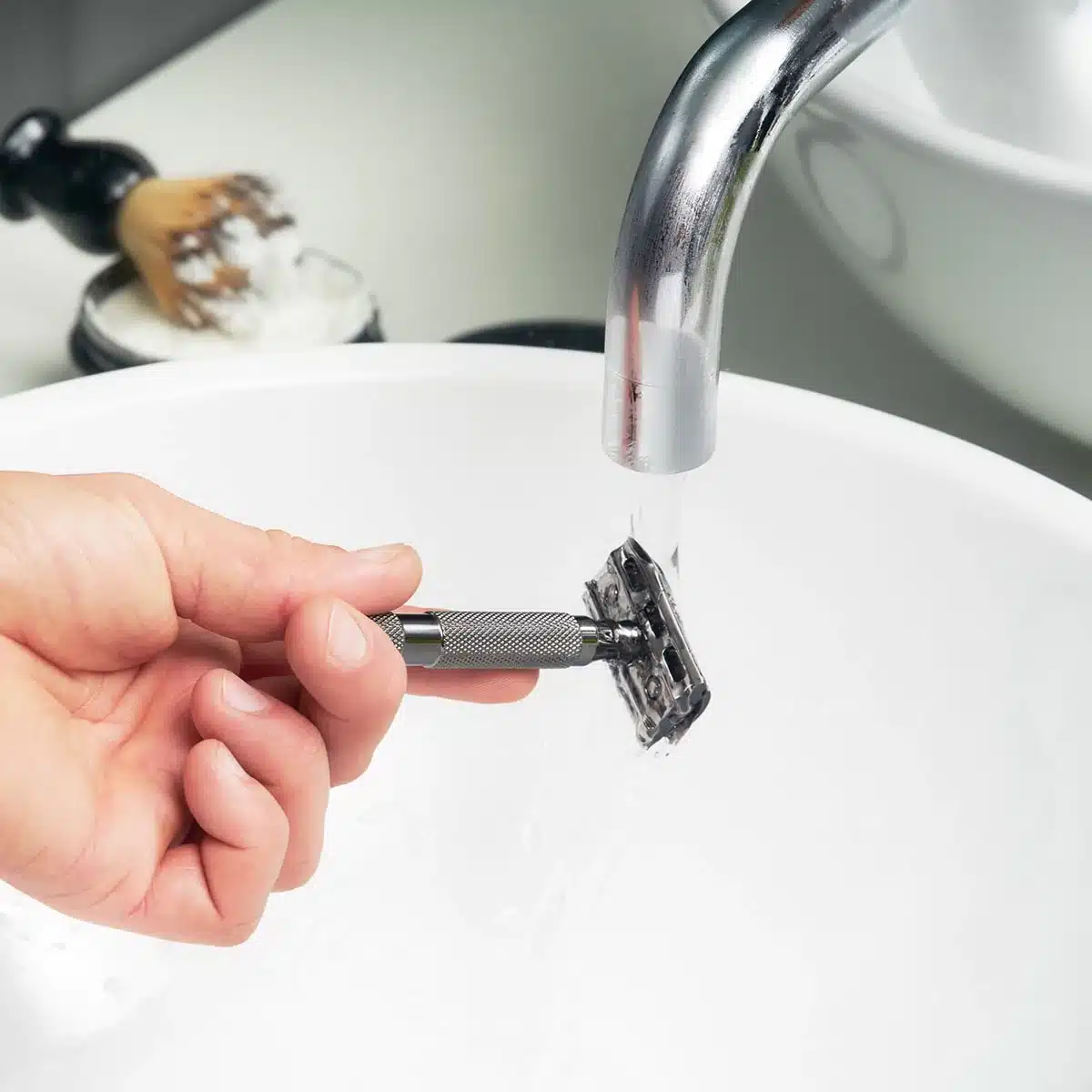While safety razors, by their very design, are intended to last for years, they must be properly maintained and cleaned.
This guide will show you how to clean your safety razor daily, weekly, and deep cleaning to remove all the gunk once and for all.
Let’s dive in:
Daily Cleaning (After Each Shave)

Once you are finished shaving, it is important to rinse your razor thoroughly with warm water. This will remove shaving cream, soap, hair, and skin cells clinging to the blade.
To do this, we recommend turning the water as hot as you can tolerate and holding the razor under the stream for at least 30 seconds. Once you have rinsed the razor, shake it off well and set it aside to air dry. Razor stands, particularly, are designed to allow your razor to dry properly by hanging the handle to let any excess water drip off.
Note: For daily cleaning, don’t worry about disassembling the razor since you should plan to do a more thorough cleaning once a week (see below).
For a Quick Disinfection
If you have sensitive skin or frequently experience razor burn, dipping your safety razor into isopropyl alcohol (rubbing alcohol) that is 70% or higher after each shave will help to disinfect the razor. A 30-second dip should do the trick.
Note: Barbers use something similar to sanitize their scissors and combs between customers; instead of isopropyl alcohol, they use Barbicide.
Weekly Cleaning
In addition to daily cleaning, giving your razor a more thorough cleaning at least once a week is important. This will help to remove any built-up residue and keep your razor in top condition. Most folks will coincide with the weekly cleaning when they swap out the razor blade for a new one, as each blade will last about five to seven shaves.
No matter which type of safety razor you own (one, two, or three-piece), cleaning is essentially the same.
Step 1: Disassemble Your Razor
Start by disassembling your razor into its individual parts. If you have a two or three-piece razor, unscrew the handle from the baseplate and cap. If you own a one-piece razor, skip to the next step.
Step 2: Remove the Blade
Remove the razor blade from the safety razor and dispose of it properly.
Step 3: Mix Soap and Water in a Bowl or Mug
Mix about 1 part soap with ten parts water in a bowl or mug. We recommend using a soap that cuts through grease, such as Dawn or Palmolive. This will be much more effective, especially if you use tallow-based shaving soaps, as they can be hard to remove.
Step 4: Soak Your Razor
Place each of your safety razor pieces into the soapy water for a minute or two to loosen up any buildup.
Step 5: Scrub with a Toothbrush or Soft Cloth
Use a toothbrush or soft cloth to scrub each piece of your razor. The goal is to lift any gunk, soap scum, dirt, and other debris that often builds up at welding points on the safety razor throughout the week.
Note: You can use a more abrasive cleaner, such as baking soda if the dirt and grime are particularly stubborn.
Step 6: Rinse Your Razor
Once you have scrubbed each piece of your razor, rinse it under warm water. You may need to repeat this step a few times to remove all traces of soap.
Step 7: Dry Your Razor
Once you have rinsed off your razor, shake off any excess water and pat it dry with a microfiber cloth, hand towel, or paper towel.
Step 8: Reassemble the Razor
Once you have dried your razor, reassemble it and place it on the razor stand. This will allow air to easily remove any excess moisture to prevent rust or corrosion.
Deep Cleaning

In addition to daily and weekly cleaning, it is also a good idea to give your razor a deep cleaning every few months. This will help to remove any built-up residue, soap scum, scale, and other debris that may have accumulated over time. Deep cleaning your safety razor is simply giving it a vinegar bath.
To deep clean your razor, you will need to:
- Disassemble your razor into its individual parts.
- Remove the razor blade from the safety razor and dispose of it properly.
- Mix about one part white vinegar with four parts water in a bowl or mug.
- Place each piece of your safety razor into the vinegar and water solution for about 20 or 30 minutes.
- Use a toothbrush or soft cloth to scrub each piece of your razor.
- Rinse your razor under warm water.
- Dry your razor with a hand towel or paper towel.
Rust Removal

If you own an heirloom or vintage safety razor, it likely has some surface rust. While this can look bad, it does not necessarily mean that your razor is unusable. Many older razors were made from stainless steel and can be easily restored to pristine quality.
There are a few ways you can do this, as we describe below:
- Oxalic Acid: This organic acid is the active ingredient in Barkeepers Friend, a popular kitchen and bathroom cleaner. You can remove rust from your razor by coating some powder onto a damp cloth and gently scrubbing the rust spots.
- WD-40: This multi-purpose lubricant can also remove rust. Simply spray some WD-40 onto the rust spots and let it sit for a few minutes. Then, use a damp cloth to scrub the rust away.
- Professional Restoration: Speciality shave shops such as Maggard Razors, Razor Emporium, and more offer professional razor restoration services. This is likely the best option to ensure your razor is restored to its original condition.
Frequently Asked Questions
Is it safe to deep clean a chrome-plated safety razor?
Yes, thoroughly cleaning a chrome-plated razor with a vinegar bath is perfectly safe. However, it’s worth noting that if the chrome is cracked at all, the razor needs to be replaced.
Should you deep-clean the safety razor blade to make it last longer?
No, washing the blade won’t make it last any longer. Given that razor blades are relatively cheap, it’s simply not worth the effort or time. Additionally, you put yourself at risk of accidentally cutting yourself if you try to clean the blade.
My safety razor is starting to rust; what should I do?
If your razor is starting to rust, you can remove the rust with solutions such as oxalic acid or WD-40. If the razor is in bad shape, you may need to take it to a professional restoration shop.
I’m out of dish detergent, does hand soap work instead?
Hand soap can work. However, it just won’t be as effective. To use hand soap, we recommend lathering it into a washcloth or sponge and then scrubbing the razor. Once an acceptable lather has formed, then use a toothbrush to scrub the razor clean.
I read somewhere that I should boil a safety razor to clean it. Is this true?
While boiling a safety razor is one way to remove bacteria, this is unnecessarily harsh and can damage the razor as the contraction and expansion of the heat on the metal frame could lead to cracks in the chrome. Opt for using rubbing alcohol, white vinegar, or soap and water solution to clean your razor instead.
Can my sink suffice instead of a bowl or mug?
Absolutely, we only recommend a separate bowl or mug if you need to use your sink for something else. If you have a double sink, feel free to use one side for your razor and the other for whatever else you need to do.